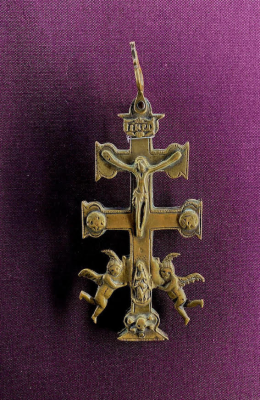Exhibition of crosses at Westminster Cathedral

Spanish Baroque Reliquary Cross. Photo by Lucien de Guise
Sadly the fascinating exhibition of some 130 crosses, in 'It's Iconic' at Westminster Cathedral is prematurely drawing to a close on 7th September.
Lucien de Guise is an experienced Museum Curator both in the UK and overseas, devised the exhibition from his own considerable collection and added to by other loans.
Over the summer it had gradually grown, and it is a vision of de Guise to find a permanent home for this unique collection showing the diversity of cultural influences and use of materials in Christendom's most iconic image.
"Could humanity have created a more arresting expression of devotion than depictions of the crucified Christ?......it is a visual reminder of how universal the church is" he says.
Exhibited above the Cathedral shop and accessed by a spiral staircase the display has been warmly welcomed by visitors from around the globe. Enthusiastic comments in the visitor's book can be seen from as far afield as Saudi Arabia, and Chile. When I was there some Ukrainian refugees were present.
The oldest cross is Byzantine made of metal from before 1000 AD.
Every cross tells a story says de Guise. Amongst his favourites are a Pax, and reliquary crosses. An early small engraved English Pax was made at the time of the Reformation and it is fascinating to think of it being used maybe in secret at Mass in a Catholic recusant home. A large gilt metal one's identity is, says de Guise, somewhat of a mystery. He found it in a Yorkshire antiques market.
An Art Deco style reliquary still contains some bones, reputedly of St.Fortunata, an early martyr. Another is the empty Spanish baroque brass reliquary from Caravaca in the shape of a Jerusalem Patriarchal cross. Murilloesque winged cherubs support either side of the base of the double crucifix, beside a seated Madonna. It is inspired by a Spanish legend of a Muslim ruler who was converted following a vision of a cross being carried by angels. At the foot of the base is a skull and cross bones (See photograph) a reminder that Golgotha is the place of the skull.
He is particularly attached to the nineteenth century Mother of Pearl exhibits from Palestine and Asia. The craftsmanship is very similar in China and Vietnam so it difficult to distinguish between them.
Mother of Pearl is very brittle to work with, requiring great skill. It is also extremely hazardous to health causing respiratory problems.
Beside them is a display of Iraqi war damaged crosses on loan from Aid to the Church in Need. One only has the feet left dangling, another an arm missing and the third has no figure and much of the cross broken. A visiting Iraqi priest from America was particularly moved on seeing them.
The Omar Ramsden Monstrance1907 is a great treasure of the Cathedral and, displayed by kind permission of the Cathedral Dean. It is a masterpiece by the famed craftsman with vibrant enamelled panels, one depicting the crucifixion.
A quirky exhibit is an Indonesian puppet of the crucified Christ that has a pop-up crown of thorns which was displayed to the congregation on Good Friday.
A late 17th century Delft porcelain tile from the Netherlands depicts the Crucifixion scene in its inimical blue and white design.
Wooden crosses from the Amazon bloodied with red paint, traditional sub Saharan African representations including loaves and fish at the foot of a framed cross and ivory crosses from Goa all contribute to this rich iconic melee of cultural diversity and universality.
An early 20th century Georgian triptych has a central panel of the crucifixion ,a left sided panel of Mary, Mother of God and the third is of a bearded figure who could be Elijah the Prophet, a saint in Eastern tradition ,(also in Western Carmelite spirituality) Elijah is linked to the Transfiguration which would place the crucifixion into the more Eastern view of looking towards Christ in Glory. Another suggestion is that the figure represents John the Baptist who is interchangeable with Elijah in Eastern iconography-and Carmelite
Two War Office moulds found in the cathedral basement for The Pledge of Victory WWI bakerite crucifix are particularly moving. Recently I discovered my Irish great uncle ,who has no known grave, is commemorated in the Cathedral's Irish chapel .I wondered whether he had been comforted by the presence of one of these crucifixes on his person when he was killed at the battle of Ypres in 1914.
De Guise has enjoyed the response of visitors and exchanging ideas." It is an organic process!" he enthuses. The fact that other people of other faiths have appreciated the display has delighted him too.
He welcomes further interest in the collection. Contact him by email: luciendeguise@yahoo.com
Last few days viewing: Free admission Wednesday 4th -Saturday 7th.September 10.30am - 4pm.


















